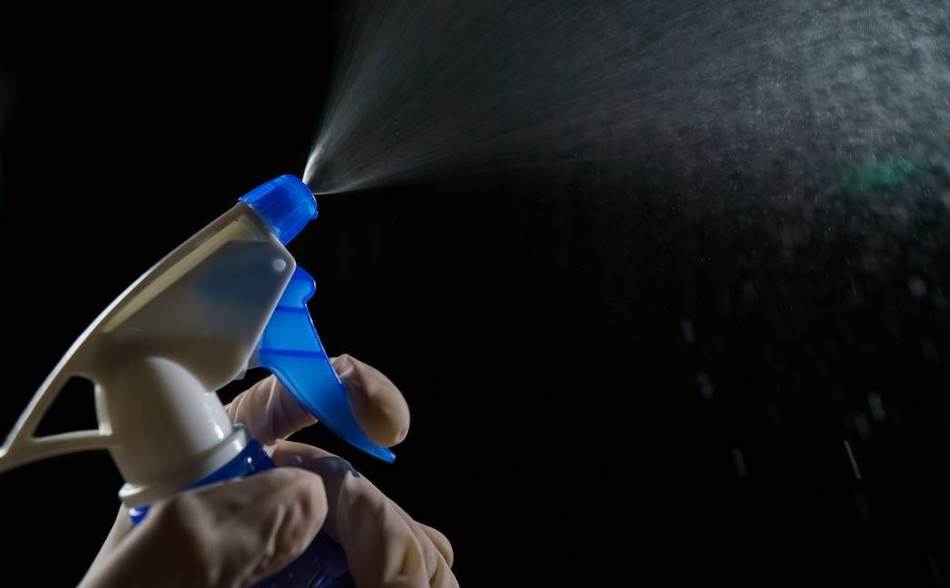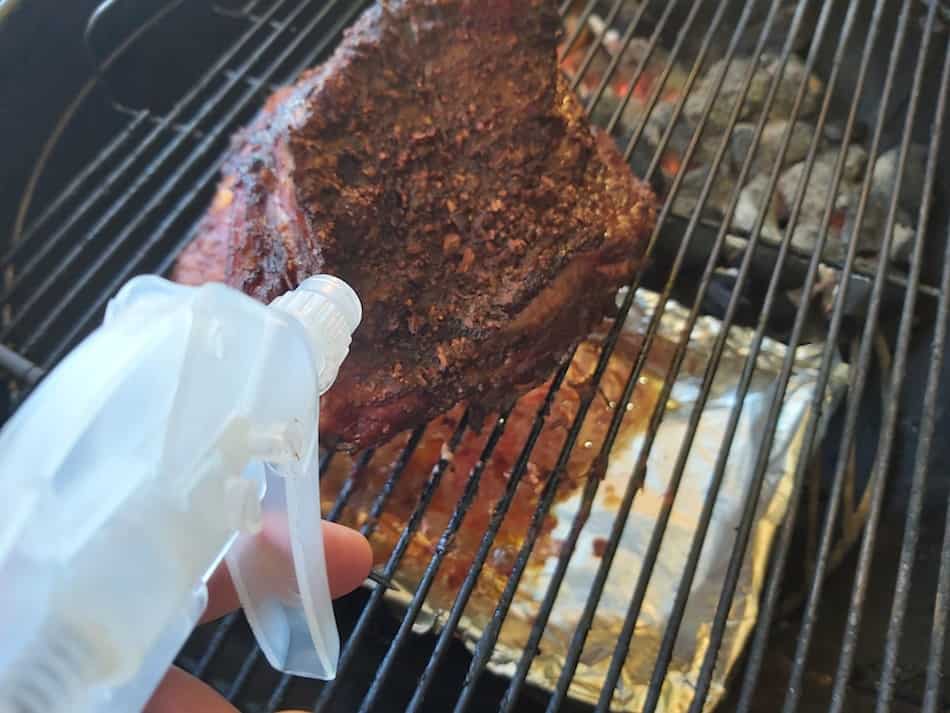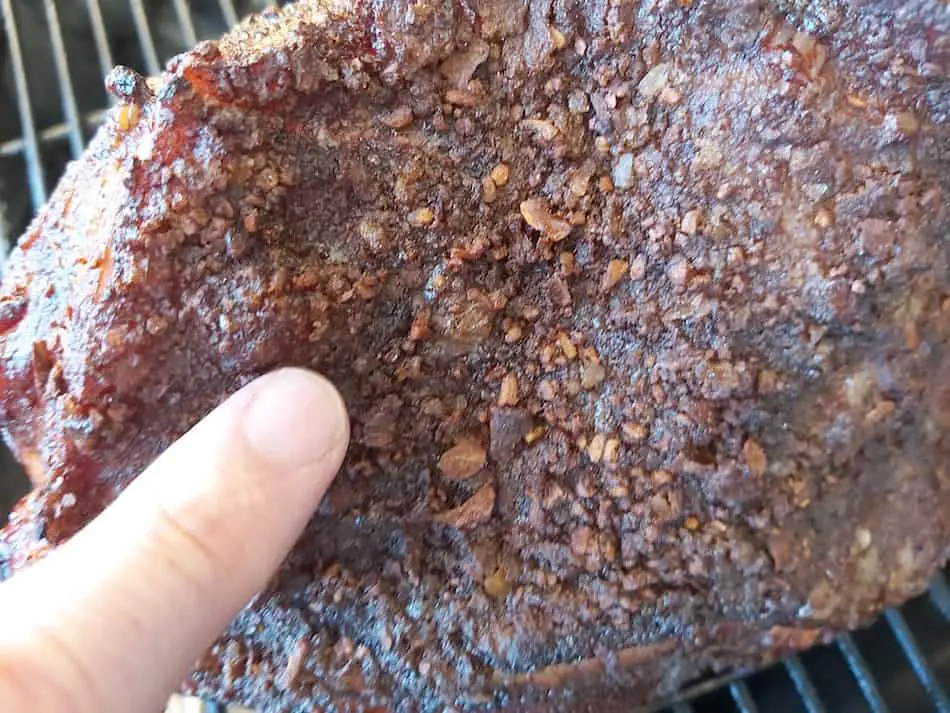
If you’ve smoked a lot of meat, you’ll know that spritzing is an important step to getting that perfect balance of smoky flavor and juicy tenderness. But with so much conflicting information out there about when to spritz, how to spritz, and what liquids to use, it can be tricky to know what to do. That’s why I decided to ask the BBQ gurus for their top tips and techniques on spritzing pork shoulder. So grab your pork, your spritz bottle, and get ready to elevate your BBQ game with this ultimate guide to spritzing pork shoulder.
Only spritz the pork butt after it has been in the smoker for 3 hours, then spritz every 30 to 40 minutes until the wrapping stage. Avoid spritzing the top fat, as it will slow the rendering process. The best liquids to spray onto the meat are apple cider vinegar, apple juice, beer, or broth. Before foiling the meat, give the pork one last spritzing before sealing the foil.
The Best Liquids to Boost Flavor and Moisture in Your Pork Shoulder
The most common spritz for pork butt is apple cider vinegar or apple juice. However, there are several spritzes you can use. They include:
- Apple Cider Vinegar
- Apple Juice
- Beer
- Broth
- Red Wine
- Water
When and How Often to Spritz Your Pork Shoulder for Maximum Results
If you’re smoking pork shoulder, it’s important to resist the temptation to spritz it for the first three hours. I know it can be tough to resist the urge to fiddle with your meat, but trust me, it’s worth it. Spritzing during this early stage can really mess with the temperature of your smoker, and it can also slow down the cooking process. You want to give that pork shoulder time to absorb all that delicious smoke and develop a nice, firm bark.
It’s also crucial to let your smoker stabilize during this initial phase. If you’re constantly opening the lid to spritz or check on your meat, you’re going to let all that hot air escape, which can affect the temperature and cause problems. On the flip side, opening the lid can also give the fire a huge shot of oxygen, which can cause the temperature to spike. So just be patient, let that pork shoulder do its thing, and all those smoky, juicy flavors will be worth the wait.
The Optimal Spritzing Schedule for Pork Butt
After 3 hours, once your pork shoulder has had a chance to soak up all that smoke and develop a nice bark, it’s time to start spritzing. But don’t go crazy with it! You want to be mindful of when and how often you spritz to get the best results.
I recommend spritzing your pork shoulder every 30 to 40 minutes until it’s time to wrap it up. This will help keep it moist and flavorful without going overboard. And here’s a pro tip I picked up from Mad Scientist BBQ – make sure you keep the fat on top of the shoulder nice and dry. Spritzing will slow down the fat rendering process, which can be a real bummer because that delicious, rendered fat is one of the best parts of the pork. So just stick to spritzing the sides of the roast, or underneath, to keep things running smoothly. And trust me, your taste buds will thank you.
| Spritz | Flavor | Reason |
|---|---|---|
| Apple Cider Vinegar | Tart, tangy | Adds a subtle tangy flavor and helps to tenderize the meat |
| Apple Juice | Sweet, fruity | Adds a sweet, fruity flavor |
| Beer | Malty, hoppy | Adds a depth of flavor |
| Broth | Savory, rich | Adds a savory depth of flavor |
| Red Wine | Dry, fruity | Adds a dry, fruity flavor and helps to tenderize the meat |
| Water | Neutral | Keeps the meat moist without adding any additional flavor |
The Pros and Cons of Spritzing
Spritzing or mopping your pork shoulder can definitely have its benefits. For one, it can help give you a better smoke ring, that lovely pinkish layer on the outer part of the meat. It can also help set the bark, that crispy, flavorful crust on the outside of the pork. And let’s not forget about the smoke – spritzing can attract even more of it to your meat, giving it a deeper, smokier flavor.
But there are also a few downsides to consider. For example, spritzing can de-stabilize the temperature of your smoker, which can be frustrating if you’re trying to maintain a consistent cook. It can also slow down the overall cook time, which isn’t ideal if you’re in a rush. And be careful not to spritz too much, because it can slow down the fat rendering process and wash off any spices you’ve applied to the meat. Additionally, spritzing can increase the risk of meat contamination, so make sure you’re using a clean, sterile bottle and liquid.
On the plus side, spritzing can help keep your meat moist and reduce shrinkage, and it can also aid in browning. Just be mindful of the pros and cons, and you’ll be well on your way to perfectly spritzed pork shoulder.
| Pros | Cons |
|---|---|
| Better smoke ring | De-stabilizes the temperature of your smoker |
| Helps set the bark | Slows down the total cook time |
| Attracts smoke | Can slow down the fat rendering process |
| Cools the meat, slowing the cook | Can wash off spices |
| Adds moisture to the cooking environment, helping the meat remain moist | Increased risk of meat contamination |
| Reduces meat shrinkage | |
| Aids in meat browning |
What Happens if you Don’t Spritz?
It’s worth mentioning that spritzing isn’t for everyone. If you want a low-maintenance cook that you can just set and forget, then feel free to skip the spritz and let that pork shoulder do its thing.
Pork shoulders are actually one of the easier roasts to cook in a smoker because they have so much fat, which acts as a lubricant and helps keep the meat moist and juicy. Leaner cuts of meat can dry out more easily, so spritzing can be a helpful way to replace some of that lost moisture.
As many pitmasters say, pork butts are already pretty forgiving, so you don’t have to worry too much about drying them out. Just make sure you have a good thermometer, and you’ll be able to tell when your pork is ready by checking the internal temperature. As long as you’re paying attention to the temp and not overcooking your meat, you should be good to go without spritzing. It’s all about finding the method that works best for you and your particular tastes.
Aaron Franklin Pork Butt (Pulled Pork) Recipe And Technique
Does Liquid Attract Smoke?
Smoke is naturally attracted to cold, wet surfaces, so spritzing your pork butt will help draw that smoke right to the meat. And if you spritz regularly during the first five to seven hours of cooking, you’ll have plenty of time for that butt to absorb all that smoky flavor.
Now, I’m not saying you should douse your pork in liquid every five minutes or anything like that. Just a regular spritz every 30 to 40 minutes should do the trick. And remember, it’s important to use the right liquids – things like apple cider vinegar, apple juice, beer, and broth can all add their own unique flavors to the mix. Just don’t overdo it, and you’ll have a smoky, flavorful pork shoulder that’ll make all your BBQ dreams come true.

Does Spritzing Influence the Smoke Ring?
Spritzing your pork can actually help you achieve a better smoke ring. The pinkish ring on the outer layer of the meat is the result of a series of chemical reactions on the surface of the meat. And spritzing can help encourage those reactions, resulting in a deeper, more pronounced smoke ring.
Without getting too scientific and explain the exact processes behind the smoke ring – if you’re interested, check out this article that goes deep into the science behind the smoke ring.
Let’s face it, we all love to show off a nice smoke ring – it’s a badge of honor to the pitmaster. However, just remember to use the right liquids and not to overdo it, and you’ll be well on your way to smoke ring glory.
One problem to monitor when mopping and spritzing is the liquid can wash the spices off your pork butt. If you are constantly mopping, wetting and brushing the surface of the meat, many of the spices can drip from the meat.
Leave the pork alone for the first 3 hours. Wait until the rub has fused to the meat, then begin spritzing. Poking the meat with your finger is the best way to tell if your pork is ready to be spritzed. If the rub sticks to your finger, give it a little longer.

Can you Taste Spritz?
The mop or spritz you use on your pork shoulder isn’t going to make a difference in the flavor. Most of that liquid is just going to drip off the meat, and the flavor molecules are so tiny that they won’t even be noticeable. People put way too much time and thought into the liquids they use to mop or spritz their smoked meat – it’s a waste of energy.
Once you understand the real purpose of spritzing and how little impact the liquid has on the final flavor of the pork, you’ll be able to stop worrying about it and focus on the other, more important aspects of the cook. Don’t get caught up in the details – keep your eye on the bigger picture, and you’ll be able to achieve perfectly cooked pork shoulder every single time.
“Pork Butt Fat-Side-Up Or Fat-Side-Down? We Look At The Pros And Cons”
How the Spritz Helps Set the Bark
During the first stage of the cook, you need to give the bark time to develop. The bark is a combination of dehydrated meat, rub, and smoke, and some people think that spritzing helps the rub fuse to the meat. Personally, I don’t think it makes that much of a difference, but hey, to each their own. Just make sure you give the bark enough time to form properly before you start spritzing.
Spritzing Slows the Cook
Spritzing is essentially a way to buy yourself more time for the collagen to break down. Pork shoulders have lots of different muscles that are loaded with collagen, and if you cooked the pork at a high temperature for a short amount of time, there wouldn’t be enough time for the collagen to break down properly. The only way for collagen to break down is with a long, slow cook at a low temperature. Once the collagen melts, it turns into this delicious, gelatinous substance that tastes absolutely incredible.
Spritzing helps to lower the temperature of the meat and slow down the cook, which is exactly what you want when you’re dealing with collagen. The longer you can keep the pork at a low temp, the better – it’ll give the collagen plenty of time to break down and transform into that delicious, flavorful gelatin.
Mopping vs Spritzing: What’s the Difference?
Mopping is just slightly different from spritzing, but it serves the same purpose. Spritzing is a lot faster and easier than mopping, because you can just spray the meat in a few seconds, while mopping is a little more complicated. To mop meat, you have to make a mop sauce and then brush the meat with a tiny mop and bucket – it’s a bit of a hassle. There are tons of different mop sauce recipes out there, but no matter what you use, the mop sauce isn’t going to make much of a difference in the flavor of the meat.
So, if you’re looking to save time and effort, spritzing is definitely the way to go. It’s just as effective as mopping, but a lot quicker and easier to do. Just keep that in mind when you’re deciding which method to use on your pork shoulder.
Classic Mop Sauce Recipe
The Benefits of a Sugary Spritz
If you use a spritz liquid that has sugar in it, your pork butt is going to end up with a darker appearance. Something like apple juice, or a liquid that contains brown sugar, will almost caramelize on the surface of the meat. This browning effect on the pork shoulder looks great when it’s finished, but it’ll also contribute to the texture of the bark. Keep in mind that this browning will also happen if your barbecue rub contains sugar.
Just be careful when you’re using sugary rubs, spritzes, and mop sauces – they can easily burn and turn the meat black if you’re not careful. Keep an eye on the temperature and make sure you don’t overdo it, otherwise you’ll end up with a burnt mess instead of a perfectly cooked pork shoulder.
“Resting Pork Butt In A Cooler – How Holding Meat Helps With Time Management”
Does the Spritz Prevent Meat Shrinkage?
Some people think that spritzing, mopping, or basting meat can help prevent shrinkage, and there is some evidence to support this. However, the difference is really minimal, so it’s not really worth considering.
I mean, sure, it’s nice to have a little extra insurance against shrinkage, but at the end of the day, the most important thing is that you’re cooking your pork shoulder properly. As long as you’re using a good recipe and following the steps carefully, you shouldn’t have to worry too much about shrinkage. Just focus on getting the cook right, and everything else will fall into place.
“Pulled Pork Sliders – (How To Smoke a Pork Butt For Sliders)”
My Favorite Meat Smoking Tools
Thanks for checking out this article. I hope you learned a few things. Here are some of my favorite tools I use when smoking brisket that may be useful to you. These are affiliate links, so if you decide to purchase any of these products, I’ll earn a commission. But in all honesty, these are the tools I recommend to my family and friends who are just starting out.
Meat Thermometer: There are dozens of fancy thermometers on the market, but I still use my trusty TP20. For around $50, I have a high-quality meat thermometer with two probes, and can track the temperature of my smoker with one probe, and my meat with the other probe. The ThermoPro TP20 is an Amazon Best Seller because it’s the easiest thermometer to operate, is durable, highly accurate, and comes with pre-programmed meat settings.
Instant Read Thermometer: Arguably, the second most important tool you need is a fast and accurate instant-read thermometer. These tools play an important role in the latter stages of the cook when the meat needs regular checking in multiple areas. I use the ThermoPro TP19 because it can do everything a ThermaPen can do, but for a fraction of the cost. You can check out the TP19 on Amazon here.
Wireless Thermometer: The latest thermometers on the market have no wires and can be controlled by wi-fi via your phone. Airprobe 3 is the best of this technology.
Butcher Paper: Wrapping brisket in butcher paper has become a huge trend in barbeque thanks to Aaron Franklin. Wrapping your brisket in paper will give you a nice brisket bark. However, you can’t just use any old paper, it has to be unwaxed, food grade paper. You can find it on Amazon here.
Advanced Thermometer and Automatic Temperature Controller: Once you’re ready to take things seriously, the FireBoard 2 Drive is a six-channel Bluetooth/Wi-Fi thermometer that can monitor up to 6 pieces of meat, control and graph your cook sessions on your smartphone, and attaches to an an automatic blower that will convert your charcoal smoker to a set-and-forget. This is one of the most advanced meat thermometers on the market. You can check it out on the FireBoard website here.
